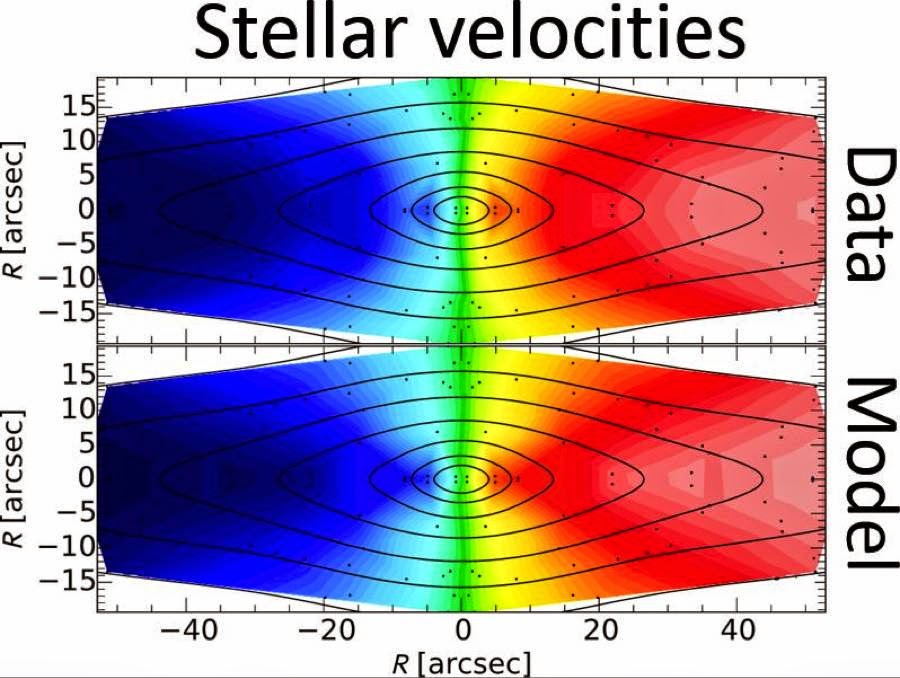Example of mapping out and analyzing the speeds of stars in an
elliptical galaxy. Blue colors show regions where the stars are hurtling
toward the observer on Earth, and red colors show regions that are
moving away, in an overall pattern of coherent rotation. The top panel
shows the original data, as collected using the DEIMOS spectrograph at
the W.M. Keck Observatory. The bottom panel shows a numerical model that
matches the data remarkably well, from using the combined gravitational
influence of luminous and dark matter. Credit: M. Cappellari and the SLUGGS team
The
speeds of stars on circular orbits have been measured around both spiral and elliptical galaxies. Without dark matter, the speeds should
decrease with distance from the galaxy, at different rates for the two
galaxy types. Instead, the dark matter appears to conspire to keep the
speeds steady. Credit: M. Cappellari and the Sloan Digital Sky Survey
Computer simulation of a galaxy, with the dark matter colorized to make it
visible. The dark matter surrounds and permeates the galaxy, holding it
together and allowing stars and planets to form. Credit: Springel et al., Virgo Consortium, Max-Planck-Institute for Astrophysics
Maunakea, Hawaii – An international team of astronomers, led by Michele Cappellari from the University of Oxford, has used data gathered by the W. M. Keck Observatory in Hawaii to analyze the motions of stars in the outer parts of elliptical galaxies, in the first such survey to capture large numbers of these galaxies. The team discovered surprising gravitational similarities between spiral and elliptical galaxies, implying the influence of hidden forces. The study will be published in The Astrophysical Journal Letters.
The
scientists from the USA, Australia, and Europe used the powerful DEIMOS
spectrograph installed on the world's largest optical telescope at Keck
Observatory to conduct a major survey of nearby galaxies called SLUGGS, which mapped out the speeds of
their stars. The team then applied Newton's law of gravity to translate these
speed measurements into the amounts of matter distributed within the galaxies.
“The
DEIMOS spectrograph was crucial for this discovery since it can take in data
from an entire giant galaxy all at once, while at the same time sampling the
speeds of its stars at a hundred separate locations with exquisite accuracy,” said
Aaron Romanowsky, of San Jose State University.
One of the most
important scientific discoveries of the 20th century was that the
spectacular spiral galaxies, such as our own Milky Way, rotate much
faster than expected, powered by an extra gravitational force of
invisible "dark matter" as it is now called. Since this discovery 40
years ago, we have learned that this mysterious substance, which is
probably an exotic elementary particle, makes up about 85 percent of the
mass in the Universe, leaving only 15 percent to be the ordinary stuff
encountered in our everyday lives. Dark matter is central to our
understanding of how galaxies form and evolve – and is ultimately one of
the reasons for the existence of life on Earth – yet we know almost
nothing about it.
“The surprising finding of our study was that
elliptical galaxies maintain a remarkably constant circular speed out to
large distances from their centers, in the same way that spiral
galaxies are already known to do,” said Cappellari. “This means that in
these very different types of galaxies, stars and dark matter conspire
to redistribute themselves to produce this effect, with stars dominating
in the inner regions of the galaxies, and a gradual shift in the outer
regions to dark matter dominance.”
However, the conspiracy does not come out naturally from models of dark matter, and some disturbing
fine-tuning is required to explain the observations. For this reason, the
conspiracy even led some authors to suggest that, rather than being due to dark
matter, it may be due to Newton's law of gravity becoming progressively less accurate at
large distances. Remarkably, decades after it was proposed, this alternative
theory (without dark matter) still cannot be conclusively ruled out.
Spiral
galaxies only constitute less than half of the stellar mass in the Universe,
which is dominated by elliptical and lenticular galaxies, and which have
puffier configurations of stars and lack the flat disks of gas
that spirals have. In these galaxies, it has been very difficult
technically to measure their masses and to find out how much dark matter
they have, and how this is distributed – until now.
Because the elliptical galaxies
have different shapes and formation histories than spiral galaxies, the newly
discovered conspiracy is even more profound and will lead experts in dark matter
and galaxy formation to think carefully about what has happened in the
"dark sector" of the universe.
“This
question is particularly timely in this period when physicists at CERN
are about to restart the Large
Hadron Collider to try to directly detect the same elusive dark matter
particle, which makes galaxies rotate fast, if it really exists!,” said
Professor Jean Brodie, principal investigator of the SLUGGS survey.
The W. M. Keck Observatory operates the
largest, most scientifically productive telescopes on Earth. The two, 10-meter
optical/infrared telescopes near the summit of Mauna Kea on the Island of
Hawaii feature a suite of advanced instruments including imagers, multi-object
spectrographs, high-resolution spectrographs, integral-field spectrographs and
world-leading laser guide star adaptive optics systems.
DEIMOS (the
DEep Imaging and Multi-Object Spectrograph) boasts the largest field of view
(16.7 arcmin by 5 arcmin) of any of the Keck instruments, and the largest
number of pixels (64 Mpix). It is used primarily in its multi-object mode,
obtaining simultaneous spectra of up to 130 galaxies or stars. Astronomers
study fields of both nearby and distant galaxies with DEIMOS, efficiently probing the most
distant corners of the universe with high sensitivity.
Keck Observatory is a private 501(c) 3
non-profit organization and a scientific partnership of the California
Institute of Technology, the University of California and NASA.
MEDIA CONTACT
Steve Jefferson
W. M. Keck Observatory
sjefferson@keck.hawaii.edu
Source: W. M. Keck Observatory


